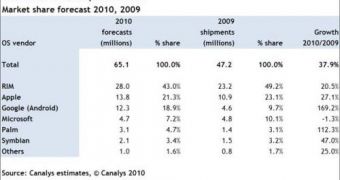A recently published report from Canalys shows that the total shipments of smartphone devices in North America are likely to reach 65.1 million units during 2010, marking an increase of 38% when compared to the last year. Moreover, the research firm also notes that the estimate builds upon the 27% growth smartphone shipments on the continent registered in 2009 compared to 2008, as their total volume reached 47.2 million units.
According to the same market study, RIM will maintain its leadership in North America throughout 2010, followed by Apple in the second place. Predictions show that both companies will experience a 21%-27% growth in shipment volumes by the end of the year, although each of them will lose a small part of their market share due to the fast-growing market. In 2009, RIM held a 49% market share in North America, while Apple accounted for 23%. This year, RIM will maintain its strong position in the corporate space, while Apple is expected to continue its fast ascend through a product update.
While RIM and Apple will continue to increase their shipment volumes in 2010, Microsoft is expected to maintain a flat line, with around 7% share of the market in North America, shipping 4.7 million units in the region. “Windows Phone 7 Series represents a major improvement to the platform that was badly needed from Microsoft. However, the delay between announcement and expected commercial availability in Q4 2009 will make this year a tough one. It will impact shipment volumes in the second and third quarters, as no vendor or carrier will want a warehouse full of Windows Phone 6.5 devices come the launch of 7,” Chris Jones, Canalys VP and principal analyst, based in Palo Alto, said.
In 2010, Android-powered smartphone shipments are predicted to increase by 169%, going from 4.7 million devices in 2009 to over 12.3 million by the end of 2010. By 2013, 21.7 million Android smartphones are expected to be shipped to North America, as companies like HTC, Samsung, Motorola, LG, and others will launch new mobile phones powered by Google's OS.
“We have seen growth in the smartphone market, until now, driven by high-end, flagship devices, but there is now a shift in focus taking place,” Tim Shepherd, Canalys analyst, commented. “Many vendors are looking to use Android and other platforms to lower the cost of smartphones, and open up the market to new customers on tighter budgets, who previously could not have afforded to buy a smartphone. The demand is clearly there - more and more consumers want to browse the Internet on their phones, download third-party applications to enhance and personalize their devices, and engage with mobile services such as social networking, e-mail and navigation. A smart phone is an excellent vehicle for that.”
In comparison with North America, the Latin American smartphone market has declined by 11% in 2009, but it is expected to increase by 30% this year, reaching a total of 11 million units. The large number of Nokia devices launched in Latin America positioned Symbian as the leading smartphone platform with a 42% market share, followed by RIM's BlackBerry with 28%. The largest smartphone markets in this region are Brazil and Mexico, with shipments of 33% and 19%, respectively.

 14 DAY TRIAL //
14 DAY TRIAL //